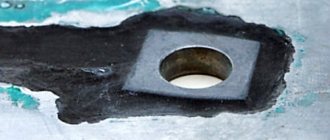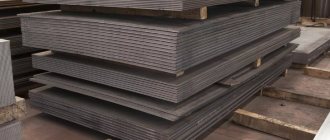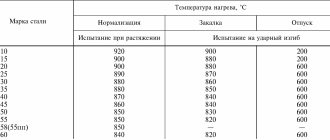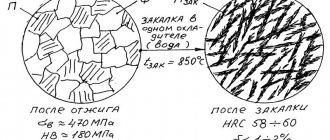Failure of threaded connections due to overtightening can occur due to destruction of the bolt shank or due to stripping of the threads of the nut and/or bolt.
A bolt or screw and nut assembly of the appropriate grade are designed to create connections that can be tightened to the bolt's specified proof load without stripping the threads. The proof load is usually 85-95% of the yield strength and is defined as the maximum tensile force that can be applied to the bolt without causing it to yield plastically.
The torque value for a particular bolt size depends on:
- Bolt material and strength class.
- Material of the parts to be connected (steel, non-ferrous metal or plastic).
- The presence or absence of an anti-corrosion coating on the screw.
- Is the fastener dry or lubricated?
- Thread lengths.
The tables below are for reference only as the values given are approximate. Because of the many factors that affect the torque-tension relationship, the only way to determine the correct torque is to conduct experiments under actual joining and assembly conditions.
Table 1. Tightening torques – screw (bolt) without coating (black), friction coefficient 0.14.
Large carving
| Thread diameter | Strength class | |||||||
| 5.6 | 8.8 | 10.9 | 12.9 | |||||
| Nm | ft lb. | Nm | ft lb. | Nm | ft lb. | Nm | ft lb. | |
| M3 | 0.6 | 0.44 | 1.37 | 1.01 | 1.92 | 1.42 | 2.3 | 1.7 |
| M4 | 1.37 | 1.01 | 3.1 | 2.29 | 4.4 | 3.05 | 5.25 | 3.87 |
| M5 | 2.7 | 1.99 | 6.15 | 4.54 | 8.65 | 6.38 | 10.4 | 7.6 |
| M6 | 4.6 | 3.3 | 10.5 | 7.7 | 15 | 11 | 18 | 13 |
| M7 | 7.6 | 5.6 | 17.5 | 12.9 | 25 | 18.4 | 29 | 21.3 |
| M8 | 11 | 8.1 | 26 | 19 | 36 | 26 | 43 | 31 |
| M10 | 22 | 16 | 51 | 37 | 72 | 53 | 87 | 64 |
| M12 | 39 | 28 | 89 | 65 | 125 | 92 | 150 | 110 |
| M14 | 62 | 45 | 141 | 103 | 198 | 146 | 240 | 117 |
| M16 | 95 | 70 | 215 | 158 | 305 | 224 | 365 | 269 |
| M18 | 130 | 95 | 295 | 217 | 420 | 309 | 500 | 368 |
| M20 | 184 | 135 | 420 | 309 | 590 | 435 | 710 | 523 |
| M22 | 250 | 184 | 570 | 420 | 800 | 590 | 960 | 708 |
| M24 | 315 | 232 | 725 | 534 | 1020 | 752 | 1220 | 899 |
| M27 | 470 | 346 | 1070 | 789 | 1510 | 1113 | 1810 | 1334 |
| M30 | 635 | 468 | 1450 | 1069 | 2050 | 1511 | 2450 | 1806 |
| M33 | 865 | 637 | 1970 | 1452 | 2770 | 2042 | 3330 | 2455 |
| M36 | 1111 | 819 | 2530 | 1865 | 3560 | 2625 | 4280 | 3156 |
| M39 | 1440 | 1062 | 3290 | 2426 | 4620 | 3407 | 5550 | 7093 |
Fine thread
| Thread diameter | Strength class | |||||
| 8.8 | 10.9 | 12.9 | ||||
| Nm | ft lb. | Nm | ft lb. | Nm | ft lb. | |
| M8x1 | 27 | 19 | 38 | 28 | 45 | 33 |
| M10x1.25 | 52 | 38 | 73 | 53 | 88 | 64 |
| M12x1.25 | 95 | 70 | 135 | 99 | 160 | 118 |
| M14x1.5 | 150 | 110 | 210 | 154 | 250 | 184 |
| M16x1.5 | 225 | 165 | 315 | 232 | 380 | 280 |
| M18x1.5 | 325 | 239 | 460 | 339 | 550 | 405 |
| M20x1.5 | 460 | 339 | 640 | 472 | 770 | 567 |
| M22x1.5 | 610 | 449 | 860 | 634 | 1050 | 774 |
| M24x2 | 780 | 575 | 1100 | 811 | 1300 | 958 |
Table 2. Tightening torques – electrolytically galvanized screw, friction coefficient 0.125.
Large carving
| Thread diameter | Strength class | |||||||
| 5.6 | 8.8 | 10.9 | 12.9 | |||||
| Nm | ft lb. | Nm | ft lb. | Nm | ft lb. | Nm | ft lb. | |
| M3 | 0.56 | 0.41 | 1.28 | 0.94 | 1.8 | 1.33 | 2.15 | 1.59 |
| M4 | 1.28 | 0.94 | 2.9 | 2.14 | 4.1 | 3.02 | 4.95 | 3.65 |
| M5 | 2.5 | 1.84 | 5.75 | 4.24 | 8.1 | 5.97 | 9.7 | 7.15 |
| M6 | 4.3 | 3.1 | 9.9 | 7.3 | 14 | 10.3 | 16.5 | 12.1 |
| M7 | 7.7 | 5.2 | 16.5 | 12.1 | 23 | 16.9 | 27 | 19.9 |
| M8 | 10.5 | 7.7 | 24 | 17.7 | 34 | 25 | 40 | 29 |
| M10 | 21 | 15 | 48 | 35 | 67 | 49 | 81 | 59 |
| M12 | 36 | 26 | 83 | 61 | 117 | 86.2 | 140 | 103 |
| M14 | 58 | 42 | 132 | 97 | 185 | 136 | 220 | 162 |
| M16 | 88 | 64 | 200 | 147 | 285 | 210 | 340 | 250 |
| M18 | 121 | 89 | 275 | 202 | 390 | 287 | 470 | 346 |
| M20 | 171 | 126 | 390 | 287 | 550 | 405 | 660 | 486 |
| M22 | 230 | 169 | 530 | 390 | 745 | 549 | 890 | 656 |
| M24 | 295 | 217 | 675 | 497 | 960 | 708 | 1140 | 840 |
| M27 | 435 | 320 | 995 | 733 | 1400 | 1032 | 1680 | 1239 |
| M30 | 590 | 435 | 1350 | 995 | 1900 | 1401 | 2280 | 1681 |
| M33 | 800 | 590 | 1830 | 1349 | 2580 | 1902 | 3090 | 2278 |
| M36 | 1030 | 759 | 2360 | 1740 | 3310 | 2441 | 3980 | 2935 |
| M39 | 1340 | 988 | 3050 | 2249 | 4290 | 3163 | 5150 | 3798 |
Fine thread
| Thread diameter | Strength class | |||||
| 8.8 | 10.9 | 12.9 | ||||
| Nm | ft lb. | Nm | ft lb. | Nm | ft lb. | |
| M8x1 | 25 | 18 | 35 | 25 | 42 | 30 |
| M10x1.25 | 49 | 36 | 68 | 50 | 82 | 60 |
| M12x1.25 | 88 | 64 | 125 | 92 | 150 | 110 |
| M14x1.5 | 140 | 103 | 195 | 143 | 235 | 173 |
| M16x1.5 | 210 | 154 | 295 | 217 | 350 | 258 |
| M18x1.5 | 305 | 224 | 425 | 313 | 510 | 376 |
| M20x1.5 | 425 | 313 | 600 | 442 | 720 | 531 |
| M22x1.5 | 570 | 420 | 800 | 590 | 960 | 708 |
| M24x2 | 720 | 531 | 1000 | 737 | 1200 | 885 |
Determining the tightening torque
Torque wrench
The selection of this tool should be carried out so that the tightening torque on the fastening element is 20-30% less than the maximum torque value on the wrench used. If you try to exceed the permissible limit, the tool can easily break.
The tightening force and grade of material must be present on each product; methods for deciphering the markings are described above.
To perform secondary tightening of bolts, you should adhere to the following recommendations:
- Know exactly the required tightening force.
- When performing a control check of tightening, it is necessary to set the force and check each fastener in a circle.
- It is forbidden to use a torque wrench as usual; it should not be used to tighten parts, nuts and bolts to obtain only an approximate force. It should be used to perform control broaching.
- The torque wrench must have a margin to measure the torque.
What happens when you tighten a bolt?
The torque applied to the nut causes it to slide up the inclined plane of the thread. This reduces the distance between the supporting surfaces of the bolt and nut. This dimension represents the grip length of the bolted joint.
When further tightened, the bolt is subjected to a tensile load. Its material, most often steel, resists this stretching and creates a clamping force on the components being held together. Likewise, backing materials resist compression to balance clamping pressure. The stress created is called fastener preload
.
Critical structural connections require tightening to a specific torque to ensure correct preload.
- A correctly tightened bolt
stretches slightly, but does not go beyond its elastic deformation area. Being under constant tension, it maintains the tightening force and exhibits resistance to fatigue failure. - An overtightened bolt
is stretched beyond its elastic elongation limits, which leads to its irreversible plastic deformation and subsequent failure. - An insufficiently tightened bolt
allows a slight gap between the workpieces being joined, which will increase after constant dynamic loading or other operating loads. A gap in the connection means there is no pre-tension, which will inevitably lead to failure of the connection.
Thus, the tightening torque is the optimum torque applied to the nut so that the bolt can securely hold the load without deforming or breaking. SI unit: Nm (Newton meter).
The pre-tightening torque of a threaded connection is a calculated value and is 75-80% of the test load. The latter serves as a control indicator that the screw must withstand during testing. If you exceed the proof torque value, you risk damaging the fastener.
Bolt Load Calculation
The bolt head marking usually contains the following data:
- manufacturer's mark (JX, THE, L, WT, etc.); — strength class; - counterclockwise arrow (if left-hand thread).
The first number indicates the nominal tensile strength (tensile strength): 1/100 MPa (1/100 N/mm2; ~1/10 kg/mm2). Example: (strength class 9.8) 9*10=900 MPa (900 N/mm2; 91.71 kg/mm2).
The second number indicates the percentage of yield strength to tensile strength (tensile strength): 1/10%. Example: (strength class 9.8) 9*8=720 MPa (720 N/mm2; 73.37 kg/mm2).
The yield strength value is the maximum permissible working load of the bolt, above which irreversible deformation occurs. When calculating the load, 1/2 or 1/3 of the yield strength is used, with a double or triple safety margin, respectively.
According to the current international classification, high-strength bolts include products whose tensile strength is greater than or equal to 800 MPa (800 N/mm2; 81.52 kg/mm2). Accordingly, starting from 8.8 for bolts and 8 for nuts.
Examples of material flow
An example would be a common kitchen fork. By bending it in one direction, you can get a completely different object, which means its fluidity is disrupted, which leads to deformation. In this case, the material only deformed, but did not break, which indicates a high degree of elasticity of the steel. Conclusion: maximum strength is much higher than yield.
Other kitchen equipment, such as a knife, will break if you try to change its shape. Conclusion: the knife has the same fluidity and strength; such a product can be called fragile, despite the fact that it is made of steel.
A similar practical example would be screwing in a nut: the bolt itself increases in length only after a certain amount of action is applied to it. If the outcome of the experiment is unfavorable, the thread on the fastener may break.
You can watch a thematic video that will show how to test bolts.
The percentage of elongation is an average indicator that demonstrates the length of the deformed part before the onset of failure. Figuratively, we can call this kind of bolts flexible, meaning precisely the ability to elongate.
The technical terminology for this is quite simple: elongation is nothing more than the percentage of increase in a sample compared to its original size.
Another advantage of preload
At first glance at the bolt assembly, it seems that the threaded fastener itself bears all the loads acting from the outside during operation. But that's not true. When an external load is applied to a preloaded connection, the bolt does not take the full load, but usually only a small part of it. When a working load is applied to a fastener that has not been preloaded, the entire load is applied to the bolt alone, increasing the likelihood of failure.
But this rule only works if the additional external loads do not exceed the preload of the bolts, otherwise the load on the threaded fasteners increases.
Material hardness
Brinell hardness is a characteristic that allows you to determine the hardness of a material.
Stainless steel fasteners are also equipped with special markings on the top of the fastener.
Type of steel A2 or A4 and tensile strength - 50, 70, 80, examples: A2-70, A4-80. Fasteners that have a clearly defined thread are color-coded for A2 in green and for A4 in red. The value for the yield strength is not specified.
For example, a value of 70 is the most standard and demonstrates the maximum strength of stainless steel fasteners.
Maximum fluidity for stainless steel hardware, often only a reference value.
The fluidity in this case will be 250 N/mm2 for A2-70 and about 300 N/mm2 for A4-80.
The approximate increase will be no more than 40%. In other words, this type of steel perfectly changes shape before irreparable deformation occurs.
Old domestic measurement methods according to GOST did not allow paying due attention to the maximum permissible loads on bolts, so the produced hardware was significantly lower in quality compared to modern ones.
An example to calculate the load on a material as accurately as possible using strength classification:
The role of friction and lubrication forces in a connection
To determine the tightening force, several special calculation methods are used, taking into account not only the strength class and thread diameter of the screw, but also the influence of galvanic coatings, special lubricants or the effect of hard and smooth mating surfaces, etc.
It should be borne in mind that the tabular data is a rough calculation and does not take into account how much torque will be lost due to friction in real assembly conditions.
When assembled dry and on rough surfaces, approximately 90% of the applied torque is due to frictional forces: 50% on the nut bearing surface and 40% between the mating threads. Thus, only about 10% of the tightening force is used to create tension.
But a way out has been found! — Reduce friction through lubrication. Lubricated threads will require 15-25% less torque to achieve the same tension, will also reduce the likelihood of fastener failure during installation and will extend the life of the fastener. Lubricant manufacturers usually indicate the coefficient of friction of the fastener that the lubricant provides.
You can also use bolts with a specified coefficient of friction, for example, with a zinc coating, which reduces the resistance when screwing.
How to use the table
Knowing the design values of the breaking load acting on the fastener and the connecting unit as a whole, you can easily select the required variations in bolt sizes. For example, for a breaking load of 32 KN, there are several suitable intersection points of rows and columns:
- 35.3 Kn – M7 bolt, strength class 12.9;
- 32.9 Kn – M8 bolt, strength class 9.8;
- 34.8 Kn – M10 bolt, strength class 6.8;
- 33.7 Kn – M12 bolt, strength class 4.6.
All threaded bolt rods from M14 already cope with the given load, regardless of the strength class. Thus, if we are talking about a compact connection with limited space for mounting bolted fasteners, it is necessary to select hardware of a higher strength class with a smaller diameter and possibly length. Otherwise, you can use more massive bolts of normal strength.
The table “Fracture loads for bolts” can also be used in reverse order, if there is a need to clarify the operational capabilities of the bolts in stock. To do this, use the information in the accompanying documentation for the fastener or the strength class marking on the head of the bolts and the actual thread diameter of the rod.








